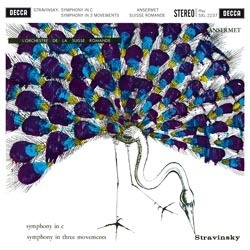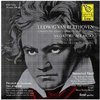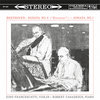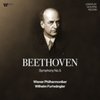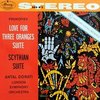AAA 100% Analogue This LP was Remastered using Pure Analogue Components Only from the Master Tapes through to the Cutting Head
SXL 2237 Decca / Speakers Corner - 180 Gram Virgin Vinyl
Limited Edition - Pure Analogue Audiophile Mastering - Pressed at Pallas Germany
Speakers Corner 25 Years Pure Analogue This LP is an Entirely Analogue Production
Igor Stravinsky: Symphony In C (1940), Symphony In Three Movements (1945) - Orchestre de la Suisse Romande conducted Ernest Ansermet
It is well known that the mature Stravinsky was candidly scathing about some of his early compositions. However, he did subscribe a measure of academic value to his very first symphony, if only to show how one should not compose. In the following decades he wrote his so-called neo-classical symphonies, but these too found no mercy in the eyes and ears of avant-garde extremists, and are thus among the most underestimated orchestral compositions of the 20th century.
The new aspiration to write with clarity and simplicity, and so turning away from late-romantic and impressionistic expression, is already found in the key of C major, which has no accidentals. But the compositional technique is tricky: sharp polytonal melodies grow out of tonal islands, which, however never result in pleasant-sounding cadences even after numerous attempts to do so.The Symphony in Three Movements, too, breaks with tradition as regards its formal structure, which Stravinsky himself regarded as »naïve«. All the more intricate, however, is the ingenious melodiousness, which is unfolded with ballet-like rhythms by the whole orchestra.
This fresh, bold music definitely needs to be performed by an astute and dauntless ensemble – such as West-Swiss Orchestre de la Suisse Romande conducted by Ernest Ansermet, an ardent champion of modern works.
Aufnahme: April 1960 in der Victoria Hall, Genf, von Roy Wallace
Produktion: Ray Minshull
Decca's sound is in a different class on both discs. The image is exceptionally large, having depth and width without any loss of focus, the orchestra is placed at the exact rear of the speakers, and there is no excessive reverberation. Analogue sound is immeasurably superior to digital (and especially low resolution 16bit files) in its ability to capture instrumental timbre, so the wind section is brought vividly to life (warts and all) and the horns in particular have vibrancy. The massed strings have exceptional presence, but there is a slight lack of body in exposed high violin passages and the double basses sound tubby on SXL 2292 (but not 2237, where the lower bass is far more controlled). As always on Decca recordings the timpani are alarmingly, thrillingly realistic - you hear the sticks hit the skins – and forte passages have weight, projection and power, with each section of the orchestra clearly audible. In an ideal world there would be greater dynamic contrast but this is a small price to pay for what remains exceptionally truthful ‘walk-in’ sound. Second label, wideband pressings were used for comparison. The Speakers Corner LPs have more vibrancy and impact, are considerably cheaper, and much easier to acquire.
Musicians:
Orchestre de la Suisse Romande
Ernest Ansermet, conductor
Selections:
Igor Stravinsky (1882-1971)
Symphony In C Major (194))
1. Moderato alla berve
2. Larghetto concertante
3. Allegretto
4. Adagio - Tempo giusts, alla breve
Side Two:
1. First movement
2. Andante - Interlude L'estesso tempo
3. con molo
AAA 100% Analogue This Speakers Corner LP was remastered using pure analogue components only, from the master tapes through to the cutting head 25 Years pure Analogue
MADE FROM THE ORIGINAL MASTER TAPES
AAA 100% ANALOGUE - PURE ANALOGUE AUDIOPHILE MASTERING
We use the Original Tapes and work with only the Best Mastering Studios Worldwide
180 GRAM VIRGIN VINYL PLATED & PRESSED AT PALLAS GERMANY
Faithful Reproduction of the Original Artwork and Labels
LIMITED EDITION Released in Limited Quantities
All Licences and Mechanical Rights Paid
Are your records completely analogue?
Yes! This we guarantee!
As a matter of principle, only analogue masters are used, and the necessary cutting delay is also analogue. All our cutting engineers use only Neumann cutting consoles, and these too are analogue. The only exception is where a recording has been made – either partly or entirely – using digital technology, but we do not have such items in our catalogue at the present time
Are your records cut from the original masters?
In our re-releases it is our aim to faithfully reproduce the original intentions of the musicians and recording engineers which, however, could not be realised at the time due to technical limitations. Faithfulness to the original is our top priority, not the interpretation of the original: there is no such thing as a “Speakers Corner Sound”. Naturally, the best results are obtained when the original master is used. Therefore we always try to locate these and use them for cutting. Should this not be possible, – because the original tape is defective or has disappeared, for example – we do accept a first-generation copy. But this remains an absolute exception for us.
Who cuts the records?
In order to obtain the most faithful reproduction of the original, we have the lacquers cut on the spot, by engineers who, on the whole, have been dealing with such tapes for many years. Some are even cut by the very same engineer who cut the original lacquers of the first release. Over the years the following engineers have been and still are working for us: Tony Hawkins, Willem Makkee, Kevin Gray, Maarten de Boer, Scott Hull, and Ray Staff, to name but a few.
At the beginning of the ‘90s, in the early days of audiophile vinyl re-releases, the reissue policy was fairly straightforward. Companies such as DCC Compact Classics, Mobile Fidelity, Classic Records and others, including of course Speakers Corner, all maintained a mutual, unwritten code of ethics: we would manufacture records sourced only from analogue tapes.
Vinyl’s newfound popularity has led many other companies to jump on the bandwagon in the hope of securing a corner of the market. Very often they are not so ethical and use every imaginable source from which to master: CDs, LPs, digital files and even MP3s.
Even some who do use an analogue tape source employ a digital delay line, a misguided ’80s and ‘90s digital technology that replaces the analogue preview head originally used to “tell” the cutter head in advance what was about to happen musically, so it could adjust the groove “pitch” (the distance between the grooves) to make room for wide dynamic swings and large low frequency excursions. Over time analogue preview heads became more rare and thus expensive.
So while the low bit rate (less resolution than a 16 bit CD) digital delay line is less expensive and easier to use than an analogue “preview head”, its use, ironically, results in lacquers cut from the low bit rate digital signal instead of from the analogue source!
Speakers Corner wishes to make clear that it produces lacquers using only original master tapes and an entirely analogue cutting system. New metal stampers used to press records are produced from that lacquer. The only exceptions are when existing metal parts are superior to new ones that might be cut, which includes our release of “Elvis is Back”, which was cut by Stan Ricker or several titles from our Philips Classics series, where were cut in the 1990s using original master tapes by Willem Makkee at the Emil Berliner Studios. In those cases we used only the original “mother” to produce new stampers.
In addition, we admit to having one digital recording in our catalogue: Alan Parsons’ “Eye in the Sky”, which was recorded digitally but mixed to analogue tape that we used to cut lacquers.
In closing, we want to insure our loyal customers that, with but a few exceptions as noted, our releases are “AAA”— analogue tape, an all analogue cutting system, and newly cut lacquers.
60 Years Pallas
Audiophile Vinyl - Made in Germany For over 60 years the family business in the third generation of the special personal service and quality "Made by Pallas" is known worldwide. Our custom PVC formulation produces consistently high pressing quality with the lowest surface noise in the industry. Our PVC complies with 2015 European environmental standards and does not contain toxic materials such as Lead, Cadmium or Toluene. Our vinyl is both audiophile and eco-grade!
